|
|
|
|
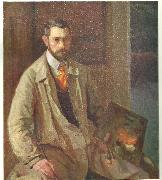 |
anders trulson
|
|
1874-1911
Anders Trulson, född 14 juli 1874 i Tosterup, död 23 augusti 1911 i Italien, var en svensk konstnär.
Anders Trulson föddes i Tosterup, där fadern var kusk på ett gods. Han fick sin utbildning i Köpenhamn och Stockholm, och blev enligt flera en dansksvensk blandning. Han bodde flera år i Lund innan hans utlandsresor började 1905, bland annat till Paris och Bregge. Trulson dog 1911 bara 37 år gammal på resa i Italien. 1902 var han med och grundade Skånska konstnärslaget som tillsammans med Konstföreningen för södra Sverige var centrum för det skånska konstlivet. Skånes konststil och liv var till stor del utanför övriga Sveriges, inte minst landskapsmåleriet vilket var präglat av ett eget färgspel. |
|
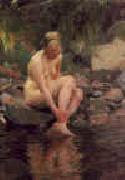 |
Anders Zorn
|
|
Swedish 1860-1920
Swedish painter, etcher and sculptor. He was brought up by his grandparents at Mora. As he displayed a precocious talent for drawing he was admitted to the preparatory class of the Kungliga Akademi for de Fria Konsterna, Stockholm, at the age of 15. Dissatisfied with the outdated teaching and discipline of the Academy and encouraged by his early success as a painter of watercolour portraits and genre scenes (e.g. Old Woman from Mora, 1879; Mora, Zornmus.) Zorn left the Academy in 1881 to try to establish an international career. He later resided mainly in London but also travelled extensively in Italy, France, Spain, Algeria and the Balkans and visited Constantinople. However, he continued to spend most of his summers in Sweden. |
|
 |
Andien de Clermont
|
|
Andien de Clermont (d.1783) was a French artist who worked in England in the 18th century (ca.1716-1756). He was particularly known for his decorative flower paintings in the Rococo style, and for "singeries, chinoiseries, and turqueries." He decorated interiors at Kirtlington Park, Langley Hall, Wentworth Castle, Wilton House, and "the second earl of Strafford's (now destroyed) dining room at No. 5 St. James's Square, London."
|
|
 |
Andras Marko
|
|
painted Landscape with Charcoal Burners in 1861 |
|
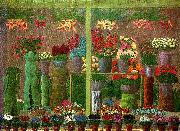 |
andre bauchant
|
|
Andre Bauchant (April 24 1873 -- August 12 1958) was a French 'naive' painter whose compositions were often informed by mythology and Classical History. He originally worked as a market gardener, after his father, before serving in World War I. He later trained as a mapmaker before deciding on a career as an artist.
Bauchant was born in Chateau-Renault, Indre-et-Loire. His first exhibit was in 1920 at the Salon d'Automne. In 1927 he was commissioned by Diaghilev to design sets for Stravinsky's Apollon Musagete. |
|
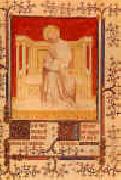 |
Andre Beauneveu
|
|
Netherlandish Gothic Era Painter and Sculptor, 1335-ca.1401
Andre Beauneveu was born in Valenciennes. Little is known about his early life and he is first documented in 1360. Four years later, he commissioned to create a collection of royal tombs in Paris for King Charles V. In 1366, Beauneveau left Paris and began working for the Count of Flanders in Courtrai beginning in 1374. Then in 1386, he began working for Jean, Duc de Berry and served him for the rest of his life. Beauneveau was primarily a sculptor, but also produced illuminated manuscripts and stained glass windows. His work was integral to the development of naturalism in the 15th century. |
|
|
|
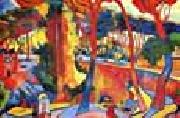 |
Andre Derain Prints
|
|
French
1880-1954
French painter and co-founder of Fauvism with Henri Matisse.
Biography The Turning Road, L Estaque (1906), The Museum of Fine Arts, HoustonAndre Derain was born in 1880 in Chatou, Yvelines, Lle-de-France, just outside Paris. In 1898, while studying to be an engineer at the Acad??mie Camillo, he attended painting classes under Eugene Carriere, and there met Matisse. In 1900, he met and shared a studio with Maurice de Vlaminck and began to paint his first landscapes. His studies were interrupted from 1901 to 1904 when he was conscripted into the French army. Following his release from service, Matisse persuaded Derain parents to allow him to abandon his engineering career and devote himself solely to painting; subsequently Derain attended the Acad??mie Julian.
Derain and Matisse worked together through the summer of 1905 in the Mediterranean village of Collioure and later that year displayed their highly innovative paintings at the Salon d Automne. The vivid, unnatural colors led the critic Louis Vauxcelles to derisively dub their works as les Fauves, or the wild beasts, marking the start of the Fauvist movement. In March 1906, the noted art dealer Ambroise Vollard sent Derain to London to compose a series of paintings with the city as subject. In 30 paintings, Derain put forth a portrait of London that was radically different from anything done by previous painters of the city such as Whistler or Monet. With bold colors and compositions, Derain painted multiple pictures of the Thames and Tower Bridge. These London paintings remain among his most popular work. |
|
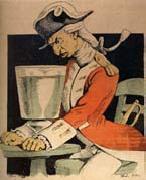 |
Andre Gill
|
|
1840-1885,was a French caricaturist. Born Louis-Alexandre Gosset de Guines at Paris, the son of the Comte de Guines and Sylvie-Adeline Gosset, he studied at this city's Academy of Fine Arts. He adopted the pseudonym Andre Gill in homage to his hero, James Gillray. Gill began illustrating for Le Journal Amusant. Gill, however, became known for his work for the weekly four-sheet newspaper La Lune, edited by Francis Polo, in which he drew portraits for a series entitled The Man of the Day. He worked for La Lune from 1865 to 1868. When La Lune was banned, he worked for the periodical L'Eclipse from 1868 to 1876. |
|
|
|
 |
Andrea Appiani
|
|
Italian Neoclassical Painter, 1754-1817
was an Italian neoclassical painter. He was born at Milan. He had been intended to follow his father's career in medicine but instead entered the private academy of the painter Carlo Maria Giudici (1723?C1804). He received instruction in drawing, copying mainly from sculpture and prints. He then joined the class of the fresco painter Antonio de' Giorgi, which was held at the Ambrosiana picture gallery in Milan. He also frequented the studio of Martin Knoller, where he deepened his knowledge of painting in oils; and he studied anatomy at the Ospedale Maggiore in Milan with the sculptor Gaetano Monti. His interest in aesthetic issues was stimulated by the classical poet Giuseppe Parini, whom he drew in two fine pencil portraits. In 1776 he entered the Accademia di Belle Arti di Brera to follow the painting courses of Giuliano Traballesi, from whom he received a mastery of the fresco technique. His best pieces are in the church of San Maria presso San Celso and the royal palace at Milan, almost rival those of his master. He was made pensioned artist to the Kingdom of Italy by Napoleon, but lost his allowance after the events of 1814 and fell into poverty. During his stint as court painter he rendered portraits of Napoleon and the chief personages of his regime. |
|
|
|
|
|
|
|
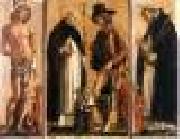 |
ANDREA DA MURANO
|
|
Italian painter, Venetian school (known 1462-1502)
Italian painter. He is first recorded working as a gilder at S Zaccaria, Venice, in 1463-5. He was one of a number of artists from the island of Murano. Among these he is closest to Bartolomeo Vivarini, whose pupil he may have been. The two collaborated in 1468 on a narrative canvas (destr.) for the Scuola di S Marco, Venice, which probably depicted scenes from the Life of Abraham. The rather harsh sculptural quality of his forms owes much to the influence of Mantegna and Donatello in Padua, and his work has often been associated (and sometimes confused) with that of Andrea del Castagno. He did not, however, ignore the more recent developments of Giovanni Bellini. His triptych depicting SS Vincent Ferrer, Roch, Sebastian and Peter Martyr, with a lunette of the Madonna of Mercy and Four Saints (Venice, Accad.), probably painted in the late 1470s, shows a real concern with light and colour. By the mid-1480s Andrea had settled in Castelfranco on the mainland, chiefly painting altarpieces in the (by then well established) Venetian sacra conversazione form. The altarpiece (1484-1502) in the parish church at Trebaseleghe, nr Padua, is a variation on the form, with Christ embracing the plague saints Sebastian and Roch above and other saints and musicians below, all showing the high degree of expression characteristic of his works. It is one of his finest paintings and also perhaps the most expensive Venetian altarpiece of its day. The altarpiece depicting the Virgin Enthroned with SS Peter, Nicholas of Bari, John the Baptist and Paul (1502; Mussolente, Santuario della Madonna dell' Acqua) is typical of Andrea's work and shows both the strengths and limitations of his art: firm draughtsmanship and expressive qualities combined with a rather conservative composition and somewhat ungainly figures. |
|
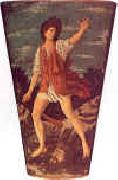 |
Andrea del Castagno
|
|
Italian
c1421-1457
Andrea del Castagno Location
Italian
c1421-1457
Andrea del Castagno Location
Italian painter. He was the most influential 15th-century Florentine master, after Masaccio, of the realistic rendering of the figure and the representation of the human body as a three-dimensional solid by means of contours. By translating into the terms of painting the statues of the Florentine sculptors Nanni di Banco and Donatello, Castagno set Florentine painting on a course dominated by line (the Florentine tradition of disegno), the effect of relief and the sculptural depiction of the figure that became its distinctive trait throughout the Italian Renaissance, a trend that culminated in the art of Michelangelo. |
|
 |
Andrea del Sarto
|
|
b.July 16, 1486, Florence
d.Sept. 28, 1530, Florence
Italian Andrea del Sarto Galleries
Andrea del Sarto (1486 ?C 1531) was an Italian painter from Florence, whose career flourished during the High Renaissance and early-Mannerism. Though highly regarded by his contemporaries as an artist "senza errori" (i.e., faultless), he is overshadowed now by equally talented contemporaries like Raphael.
Andrea fell in love with Lucrezia (del Fede), wife of a hatter named Carlo, of Recanati; the hatter dying opportunely, Andrea married her on 26 December 1512. She has come down to us in many a picture of her lover-husband, who constantly painted her as a Madonna and otherwise; even in painting other women he made them resemble Lucrezia. She was less gently handled by Giorgio Vasari, a pupil of Andrea, who describes her as faithless, jealous, and vixenish with the apprentices; her offstage character permeates Robert Browning's poem-monologue "Andrea del Sarto called the 'faultless painter'" (1855) .
He dwelt in Florence throughout the memorable siege of 1529, which was soon followed by an infectious pestilence. He caught the malady, struggled against it with little or no tending from his wife, who held aloof, and he died, no one knowing much about it at the moment, on 22 January 1531, at the comparatively early age of forty-three. He was buried unceremoniously in the church of the Servites. His wife survived her husband by forty years.
A number of paintings are considered to be self-portraits. One is in the National Gallery, London, an admirable half-figure, purchased in 1862. Another is at Alnwick Castle, a young man about twenty years, with his elbow on a table. Another youthful portrait is in the Uffizi Gallery, and the Pitti Palace contains more than one. |
|
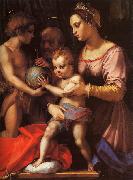 |
Andrea del Sarto
|
|
Italian High Renaissance Painter , 1486-1530
Italian painter and draughtsman. He was the leading painter in Florence in the early years of the 16th century, and, under the influence of Leonardo da Vinci, Fra Bartolommeo, Michelangelo and Raphael, he elaborated and perfected the classical style of the High Renaissance. In the second decade of the 16th century his art anticipated aspects of Mannerism, while his direct, immediate works of the 1520s became important models for the more naturalistic Tuscan artists of the Counter-Reformation. He painted mainly religious works, including both altarpieces and major cycles of frescoes. His portraits, distinguished by a dreamily poetic quality, |
|
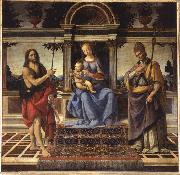 |
Andrea del Verrocchio
|
|
Italian Early Renaissance Sculptor, ca.1435-1488
Florentine sculptor and painter, whose real name was Andrea di Michele di Francesco di Cioni. He was a leading figure in the early Renaissance, and his workshop was a center for the training of young artists in Florence. A virtuoso metalworker, Verrocchio was primarily concerned with the spirited rendering of movement and the elaboration of detail. Many of his paintings are lost. Of the remaining panels, his hand is evident in the Baptism of Christ (Uffizi), assisted by Leonardo da Vinci. In the Pistoia altarpiece he was aided by Lorenzo di Credi. Other attributions are Tobias and the Angel (National Gall., London), two paintings of the Madonna and Child (National Gall., London; Berlin), and a Crucifixion with Saints (Argiano). Most of Verrocchio's achievements in sculpture have survived. His earlier work includes the bold group Incredulity of St. Thomas (Orsanmichele). In 1472 he designed the tombs of Piero and Giovanni de' Medici (San Lorenzo). In the same period he created the graceful Boy with a Dolphin and a lithe portrayal of David (Bargello). He went to Venice (c.1480) to work on the equestrian monument of the condottiere Bartolomeo Colleoni. |
|
|
|
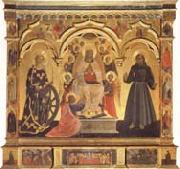 |
Andrea Di Giusto
|
|
b Florence, c. 1400; d Florence, 2 Sept 1450
Italian painter. He was an eclectic minor Florentine master who was influenced by, and at different times imitated, the styles of Masaccio, Masolino, Lorenzo Monaco, Fra Angelico and Domenico Veneziano. In 1426 he was an assistant of Masaccio in the execution of the altarpiece for the Carmine church in Pisa (London N.G.; Naples, Capodimonte; Berlin, Gem?ldegal.; Malibu, CA, Getty Mus.; Pisa, Mus. N. & Civ. S Matteo) and painted its predella panels of the Legend of St Julian and the Charity of St Nicholas (Berlin, Gem?ldegal.). His name appears in the tax registers of the Florentine Archivio delle Decime from 1427 to 1447 and in the protocols of the Arte della Calimala in 1436, the same year in which he received 60 florins for an altarpiece (destr.) for S Lucia dei Magnoli. In 1437 he signed and dated the Assumption of the Virgin with SS Catherine and Francis (Florence, Accad.). His other dated works are a Virgin and Child with Four Saints (1435; Prato, Mus. Com.), which is a copy of Lorenzo Monaco's Monte Oliveto Altarpiece of 1410 (Florence, Pal. Davanzati); a Virgin and Child (1435; Florence, Villa I Tatti), a rustic interpretation of a Virgin and Child by Fra Angelico (Turin, Gal. Sabauda) |
|
|
|
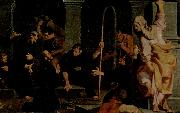 |
Andrea Lilio
|
|
Andrea Lilio (1555/1570 - after 1639) was an Italian painter born in Fano, not far from Ancona, hence he also is known as L'Anconitano.
Die Geschichte des Hl. NikolausHe painted mainly in his native city, as well as in Rome, where he was active from the beginning of the 17th century until around 1640. He was employed by Pope Sixtus V in the decoration of the library of the Vatican and in the decoration of the Scala Santa in San Giovanni Laterano. In the latter, he painted, Moses striking the Rock and Moses with the Brazen Serpent.
Said to have been a pupil of Federico Barocci, he painted in a Mannerist style, already outdated in Baroque Rome at the time. Nevertheless, Lilio created a popular niche for himself by painting allegories for aristocratic audiences. In fact, it is altogether possible that Lilio collaborated for the illustrations of Cesare Ripa's Iconologia, which was a popular source for such motifs for a very long time. He died at Ascoli Piceno.
In a chapel of the Chiesa Nuova, he painted The Archangel Michael driving fallen angels from Heaven. He continued to ornament churches and convents of Rome during the reign of Pope Clement VIII.
One of his masterpieces, the Martyrdom of Saint Lawrence, was painted for Santa Caterina in Ancona. He painted the Christ Washing the Feet of His Disciples for the nave of Santa Maria Maggiore in Rome. He also was part of the team active in the painting of the Sistine chapel (chapel of Nativity) in Santa Maria Maggiore. For the cathedral of Fano, he painted a picture of All Saints. |
|
 |
Andrea Locatelli
|
|
was an Italian painter of landscapes (vedute). 1695-1741
Born in Rome, he was the son and pupil of the painter Piero Locatelli, who had studied with the Florentine Ciro Ferri. He next apprenticed under Paolo Anesi, although his style and thematic is akin to that of Claude Lorrain, and depicts small mythologic figures although within a wild environment more similar to those of Salvator Rosa. He is also known as Andrea Lucatelli. Andrea excelled in painting vedute in a style reminiscent of Jan Frans van Bloemen, one of the Bamboccianti. One of his pupils was Joseph Vernet.
|
|
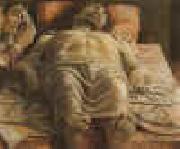 |
Andrea Mantegna
|
|
Italian
1431-1506
Andrea Mantegna Locations
Mantegna was born in Isola di Carturo, close to Padua in the Republic of Venice, second son of a carpenter, Biagio. At the age of eleven he became the apprentice of Francesco Squarcione, Paduan painter. Squarcione, whose original vocation was tailoring, appears to have had a remarkable enthusiasm for ancient art, and a faculty for acting. Like his famous compatriot Petrarca, Squarcione was something of a fanatic for ancient Rome: he travelled in Italy, and perhaps Greece, amassing antique statues, reliefs, vases, etc., forming a collection of such works, then making drawings from them himself, and throwing open his stores for others to study. All the while, he continued undertaking works on commission for which his pupils no less than himself were made available.
San Zeno Altarpiece, (left panel), 1457-60; San Zeno, VeronaAs many as 137 painters and pictorial students passed through Squarcine's school, which had been established towards 1440 and which became famous all over Italy. Padua was attractive for artists coming not only from Veneto but also from Tuscany, such as Paolo Uccello, Filippo Lippi and Donatello. Mantegna's early career was shaped indeed by impressions of Florentine works. At the time, Mantegna was said to be a favorite pupil; Squarcione taught him the Latin language, and instructed him to study fragments of Roman sculpture. The master also preferred forced perspective, the lingering results of which may account for some Mantegna's later innovations. However, at the age of seventeen, Mantegna separated himself from Squarcione. He later claimed that Squarcione had profited from his work without paying the rights.
His first work, now lost, was an altarpiece for the church of Santa Sofia in 1448. The same year Mantegna was called, together with Nicol?? Pizolo, to work with a large group of painters entrusted with the decoration of the Ovetari Chapel in the apse of the church of Eremitani. It is probable, however, that before this time some of the pupils of Squarcione, including Mantegna, had already begun the series of frescoes in the chapel of S. Cristoforo, in the church of Sant'Agostino degli Eremitani, today considered his masterpiece. After a series of coincidences, Mantegna finished most of the work alone, though Ansuino, who collaborated with Mantegna in the Ovetari Chapel, brought his style in the Forl?? school of painting. The now censorious Squarcione carped about the earlier works of this series, illustrating the life of St James; he said the figures were like men of stone, and had better have been colored stone-color at once.
This series was almost entirely lost in the 1944 Allied bombings of Padua. The most dramatic work of the fresco cycle was the work set in the worm's-eye view perspective, St. James Led to His Execution. (For an example of Mantegna's use of a lowered view point, see the image at right of Saints Peter and Paul; though much less dramatic in its perspective that the St. James picture, the San Zeno altarpiece was done shortly after the St. James cycle was finished, and uses many of the same techniques, including the classicizing architectural structure.)
San Luca Altarpiece, 1453; Tempera on panel; Pinacoteca di Brera, MilanThe sketch of the St. Stephen fresco survived and is the earliest known preliminary sketch which still exists to compare to the corresponding fresco. Despite the authentic look of the monument, it is not a copy of any known Roman structure. Mantegna also adopted the wet drapery patterns of the Romans, who derived the form from the Greek invention, for the clothing of his figures, although the tense figures and interactions are derived from Donatello. The drawing shows proof that nude figures were used in the conception of works during the Early Renaissance. In the preliminary sketch, the perspective is less developed and closer to a more average viewpoint however.
Among the other early Mantegna frescoes are the two saints over the entrance porch of the church of Sant'Antonio in Padua, 1452, and an altarpiece of St. Luke and other saints (at left) for the church of S. Giustina, now in the Brera Gallery in Milan (1453). As the young artist progressed in his work, he came under the influence of Jacopo Bellini, father of the celebrated painters Giovanni and Gentile, and of a daughter Nicolosia. In 1453 Jacopo consented to a marriage between Nicolosia to Mantegna in marriage.
|
|
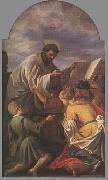 |
Andrea Pozzo
|
|
Italian Baroque Era Painter, 1642-1709
Italian painter, architect and stage designer. He was a brilliant quadratura painter, whose most celebrated works, such as the decoration of the church of S Ignazio in Rome, unite painting, architecture and sculpture in effects of overwhelming illusionism and are among the high-points of Baroque church art. He was a Jesuit lay brother and produced his most significant work for the Society of Jesus. This affiliation was fundamental to his conception of art and to his heightened awareness of the artist's role as instrumental in proclaiming the faith and stimulating religious fervour. The methods he used were those of Counter-Reformation rhetoric, as represented in Ignatius Loyola's Spirited Exercises (1548). |
|
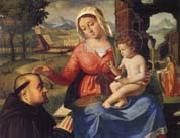 |
Andrea Previtali
|
|
Italian Early Renaissance Painter, ca.1470-1528,was an Italian painter of the Renaissance period, active mainly in Bergamo. He was a pupil of the painter Giovanni Bellini. In Bergamo, he painted a John the Baptist preaching with other saints (1515) for the church of Santo Spirito; a San Benedetto and other saints for the Cathedral of Bergamo, and a Deposition from the Cross for Sant Andrea. |
|
 |
Andrea Sacchi
|
|
1559-1661
Italian
Andrea Sacchi Gallery
As a young man, Sacchi had worked under Cortona in Castel Fusano (1627-1629). But in a set of public debates later developed in the Roman Artist's Guild, Accademia di San Luca, he strongly criticized Cortona's exuberance. In particular, Sacchi advocated that since a unique, individual expression needs to be assigned to each figure in a composition, a painting should not consist of more than about ten figures. In a crowded composition, the figures would be deprived of individuality, and thus cloud the particular meaning of the piece. In some ways this is a reaction against the zealous excess of crowds in paintings by men such as Zuccari of the prior generation, and by Cortona among his contemporaries. Simplicity and unity were essential to Sacchi. Cortona argued that large paintings were more like an epic, that could avail themselves of multiple subplots. The encrustation of a painting with excess decorative details, including melees of crowds, would represent "wall-paper" art rather than focused narrative. Among the partisan's of Sacchi's argument for simplicity and focus were his friends, the sculptor Algardi and painter Poussin.
The controversy was however less pitched than some suggest, and also involved the dissatisfaction that Sacchi and Albani, among others, shared regarding the artistic depiction of low or genre subjects and themes, such as preferred by the Bamboccianti and even the Caravaggisti. They felt that high art should focus on exalted themes- biblical, mythologic, or from classic history.
Sacchi, who worked almost always in Rome, left few pictures visible in private galleries. He had a flourishing school: Poussin and Carlo Maratta were younger collaborators or pupils. In Maratta's large studio, Sacchi's preference for grand manner style would find pre-eminence among Roman circles for decades to follow. But many others worked under him or his influence including Luigi Garzi, Francesco Lauri, Andrea Camassei and Giacinto Gimignani. Sacchi's own illegitimate son Giuseppe, died young after giving very high hopes.
Sacchi died at Nettuno in 1661. |
|
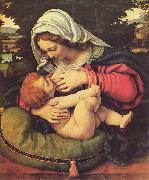 |
Andrea Solario
|
|
Andrea Solari (also Solario) (1460 in Milano - 1524) was an Italian Renaissance painter. He was initially named Andre del Gobbo, but more confusingly as Andrea del Bartolo a name shared with two other Italian painters, the 14th Century Siennese Andrea di Bartolo, and the 15th Century Florentine Andrea di Bartolo. |
|
 |
Andrea Soldi
|
|
Italian
C1703-1771
Italian painter. George Vertue, the only source for Soldi's earliest years, described him in 1738 as a Florentine aged 'about thirty-five or rather more' who had been in England 'about two years'. He had previously been in the Middle East, where he painted some British merchants of the Levant Company who had advised him to go to London. Two three-quarter-length portraits called Thomas Sheppard (1733 and 1735-6; ex-art market, London, 1917 and 1924, see Ingamells, 1974) belong to this period. In London Soldi enjoyed considerable success in the period between 1738 and 1744; Vertue reported that he began 'above thirty portraits' between April and August 1738. He was extensively patronized by the 2nd and 3rd Dukes of Manchester (eight portraits, sold Kimbolton Castle, Cambs, 18 July 1949), the 3rd Duke of Beaufort (four portraits at Badminton House, Glos) and the 4th Viscount Fauconberg (eight portraits at Newburgh Priory, N. Yorks). The seated three-quarter-length of Isabella, Duchess of Manchester, as Diana (1738; London, Colnaghi's, 1986) and the informal full-length of Lord Fauconberg (c. 1739; Newburgh Priory, N. Yorks) exemplify his lively handling, strong colour and theatrical, Italianate imagination. In a less extravagant vein, the Duncombe Family (1741; priv. col., see Ingamells, 1974), a conversation piece of some charm, and the Self-portrait (1743; York, C.A.G.) suggest a versatile talent. Soldi's bravura contrasted with contemporary English portrait practice, then wavering between the sober manner of Kneller and a playful Rococo, and his attraction for Italianate Englishmen was obvious. He was rivalled only by Jean-Baptiste van Loo, who was in London between 1737 and 1742; both artists painted the dealer Owen McSwiny and the poet Colley Cibber about 1738. He far outclassed his Italian rivals, the Cavaliere Rusca (1696-1769), who worked in London from 1738 to 1739, and Andrea Casali, who was in London from 1741 to 1766. |
|
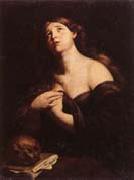 |
Andrea Vaccaro
|
|
Italian Baroque Era Painter, 1604-1670
He first studied literature but at an early age turned to painting. He was probably a pupil of the late-Mannerist painter Gerolamo Imparato, though there are no known works from this period. About 1620 he became a follower of Caravaggio; he copied Caravaggio's Flagellation (Naples, Capodimonte), and his copy and the original hung in S Domenico Maggiore, Naples (copy in situ). David with the Head of Goliath (Florence, Fond. Longhi) and Sebastian (Naples, Capodimonte) are early works indebted to Caravaggio's naturalism and chiaroscuro. After 1630 Vaccaro drew inspiration from Guido Reni, Anthony van Dyck and Pietro Novelli and made copies of their works for Neapolitan collectors and dealers such as Gaspar Roomer and Jan Vandeneyden. |
|
 |
Andrea Vanni
|
|
Italian Byzantine Style Painter , ca.1332-1414
was an Italian painter of the early Renaissance. He was born in Siena, and in conjunction with Bartolo di Maestro Fredi, began to paint in 1353. He seems to have been important in Siena, having been elected a member of the Great Council in 1370, Gonfaloniero in 1371, sent as Envoy to the Pope at Avignon in 1372, on a mission to Florence in 1373, and again as Envoy to the Pope at Naples in 1384. Many examples exist of his paintings between 1353 and 1414 in Naples and its vicinity. At the chapel of St. Catherine of Siena, in the church of San Domenico, Naples, can be found the remains of a fresco painted by him to commemorate the life of that saint, who was a correspondent and perhaps a relation of his own. A letter from St. Catherine to Vanni survives. About the year 1400, |
|
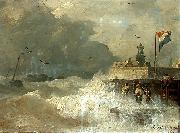 |
Andreas Achenbach
|
|
(September 29, 1815 - April 1, 1910) was a German landscape painter.
Born at Kassel, he began his art education in 1827 in Desseldorf under Friedrich Wilhelm Schadow at the Desseldorf Academy of Painting. He studied at St Petersburg and travelled in Italy, Holland and Scandinavia.In his early work he followed the pseudo-idealism of the German romantic school, but on removing to Munich in 1835, the stronger influence of Louis Gurlitt turned his talent into new channels, and he became the founder of the German realistic school. Although his landscapes evince too much of his aim at picture-making and lack personal temperament, he is a master of technique, and is historically important as a reformer. The Chambers Biographical Dictionary says of him that "he was regarded as the father of 19th century German landscape painting."
A number of his finest works are to be found at the Berlin National Gallery, the New Pinakothek in Munich, and the galleries at Dresden, Darmstadt, Cologne, Desseldorf, Leipzig and Hamburg.
He died in Desseldorf.
His brother, Oswald Achenbach (1827-1905), was also a painter.
|
|
|
|
|
|
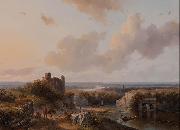 |
Andreas Schelfhout
|
|
(February 16, 1787, The Hague - April 19, 1870, The Hague) was a Dutch painter, etcher and lithographer, known for his landscape paintings.
He belongs to the Romantic movement. His Dutch winter scenes and frozen canals with skaters were already famous during his lifetime. He became one of the most influential Dutch landscape artists of his century.
He started as a house painter in the framing business of his father. He already started painting pictures in his spare time. After a well-received first exhibition in The Hague, his father sent him to receive proper training to Joannes Breckenheimer (1772-1856), a stage designer, in The Hague. He learned not only the technical aspects of painting, but also made detailed studies of the 17th-century Dutch landscape artists Meindert Hobbema en Jacob van Ruisdael.
In 1815 he started his own workshop. Through his technical excellence and sense of composition and his use of naturalistic colours, he soon became famous also outside The Hague. In 1819 he was awarded the Gold Medal at the exhibition in Antwerp. In 1818 he became a member of the Royal Academy for Visual Arts of Amsterdam. He reputation continued to grow and in1822 he was given the rank of Fourth Class Correspondent of the Royal Dutch Institute. From then on, one exhibition followed after another.
Initially he painted mainly summer scenes, beach scenes, and animal paintings. But as his initial winter scenes even had more success, he began to include them in his exhibitions. He was mainly a studio artist, relying on his sketches done en plein air. His sketchbook Liber Veritatis (Book of Truth) shows that he made about twenty paintings a year, among them a few foreign views. This indicated that he travelled abroad around 1825. In later years he visited France in 1833, England in 1835 (especially to study the works of Constable) and Germany.
He provided training to several painters who would become famous in their own right : Johan Hendrik Weissenbruch, Johan Jongkind (one of the forerunners of the Impressionists), Charles Leickert, Jan Willem van Borselen, Nicholas Roosenboom, Willem Troost, the American Hudson River School Painter Louis Remy Mignot and his son-in-law Wijnand Nuyen.
At the end of his career he put together a series of eighty landscape drawings, mainly recordings of previous paintings and watercolours. They were drawn in chalk and lightly coloured.
His death marked the end of the Romantic period in Holland. He is considered a precursor of the Hague School
|
|
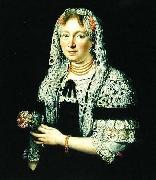 |
Andreas Stech
|
|
painted Portrait of a Patrician Lady from Gdansk in 1685 |
|
 |
Andrei Ryabushkin
|
|
(Russian:29 October [O.S. 17 October] 1861 - 10 May [O.S. 27 April] 1904) was a Russian painter. His major works were devoted to life of ordinary Russians of the 17th century.
Andrey Petrovich Ryabushkin was born in the village Stanichnaya sloboda, Borisoglebskiy uezd, Tambov gubernia in 1861. His father and brother were icon painters, and he started to help them from his early childhood. At 14 years old he became an orphan. A student of Moscow School of Painting, Sculpture and Architecture A. Kh. Preobrazhensky, who spent the summer in the village, happened to see the boyes drawings and was greatly impressed by them. He started to give him lessons and helped him to enter the Moscow School of Painting, Sculpture and Architecture. Ryabushkin was one of the youngest student of the school at all times.
Ryabushkin stayed for seven years (1875-82) in the Moscow School, learning from Vasily Perov and Illarion Pryanishnikov. His first large work Peasant Wedding was bought by Pavel Tretyakov in 1880. After the death of Vasiliy Perov, Ryabushkin moved to Saint Petersburg in 1882, and entered the Imperial Academy of Arts where he learned from Pavel Chistyakov. The classes soon disappointed him, however, and he began to spend more and more time either in the library of the academy or sketching in the streets.
His studies at the academy came to an end in 1892. He did not receive an award for his diploma work, Descent from the Cross, as was expected, because he did not follow the approved project. But the work was so good that the president of the academy, Grand Duke Vladimir Konstantinovich, provided Ryabushkin with a stipend for travel and studies abroad from his own means. Instead of going to Italy or Paris, Ryabushkin chose to make a tour of ancient Russian towns (Novgorod, Kiev, Moscow, Uglich, Yaroslavl). The inhabitants of them became his first models and his first critics. |
|
|
|
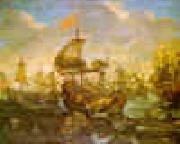 |
Andries van Eertvelt
|
|
1590-1652
Flemish
Andries van Eertvelt Location
Flemish painter. He enrolled as a member of Antwerp Guild of St Luke in 1609. In 1615 he married Catherine Vlieger (d 1627), after whose death he went to Genoa, where he worked for Cornelis de Wael. By c. 1630 he was back in Antwerp, where he had his portrait painted by Anthony van Dyck (1632; Augsburg, Schaezlerpal.). In 1633 Eertvelt married Elisabeth Boots, probably a daughter of the Antwerp painter Jan Boots (b before 1620). Eertvelt is regarded as the first Flemish marine painter. Over the years his palette and style changed. His first paintings, mostly of ships in storms (e.g. Sea Battle in a Storm; Schwerin, Staatl. Mus.), were painted in greenish-black and brown tones, often using white to highlight the rigging against the dark sea. After his tour of Italy he favoured views of southern harbours, with calm seas painted in soft tones (e.g. Spanish Ships Leaving a Port; Vienna, Ksthist. Mus.). In his day Eertvelt was a man of distinction whose artistic qualities were praised by the poet Cornelis de Bie and whose marine paintings were appreciated abroad, some being exported as far as Seville and Lisbon. His pupils included Gaspard van Eyck (1613-73), Hendrik Minderhout (1632-96) and Matthieu van Plattenberg. |
|
|
|
|
|
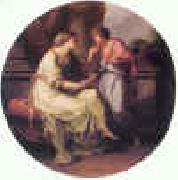 |
Angelica Kauffmann
|
|
Swiss(Resident in England)
1741-1807
She was born at Chur in Graub??nden, Switzerland, but grew up in Schwarzenberg in Vorarlberg/Austria where her family originated. Her father, Joseph Johann Kauffmann, was a relatively poor man but a skilled painter that was often traveling around for his works. He was apparently very successful in teaching his precocious daughter. She rapidly acquired several languages from her mother Cleophea Lutz, read incessantly, and showed marked talents as a musician. Her greatest progress, however, was in painting; and in her twelfth year she had become a notability, with bishops and nobles for her sitters. In 1754 her father took her to Milan. Later visits to Italy of long duration followed: in 1763 she visited Rome, returning again in 1764. From Rome she passed to Bologna and Venice, being everywhere feted and caressed, as much for her talents as for her personal charms.
Writing from Rome in August 1764 to his friend Franke, Winckelmann refers to her exceptional popularity. She was then painting his picture, a half-length, of which she also made an etching. She spoke Italian as well as German, he says; and she also expressed herself with facility in French and English, one result of the last-named accomplishment being that she became a popular portraitist for English visitors to Rome. "She may be styled beautiful," he adds, "and in singing may vie with our best virtuosi." While at Venice, she was induced by Lady Wentworth, the wife of the German ambassador, to accompany her to London. One of her first works was a portrait of David Garrick, exhibited in the year of her arrival at "Mr Moreing's great room in Maiden Lane." The rank of Lady Wentworth opened society to her, and she was everywhere well received, the royal family especially showing her great favour.
Her firmest friend, however, was Sir Joshua Reynolds. In his pocket-book, her name as Miss Angelica or Miss Angel appears frequently, and in 1766 he painted her, a compliment which she returned by her Portrait of Sir Joshua Reynolds. Another instance of her intimacy with Reynolds is to be found in her variation of Guercino's Et in Arcadia ego, a subject which Reynolds repeated a few years later in his portrait of Mrs Bouverie and Mrs Crewe.
When, in about November 1767, she was entrapped into a clandestine marriage with an adventurer who passed for a Swedish count (the Count de Horn), Reynolds helped extract her. It was doubtless owing to his good offices that she was among the signatories to the famous petition to the king for the establishment of the Royal Academy of Painting and Sculpture. In its first catalogue of 1769 she appears with "R.A." after her name (an honour she shared with one other lady, Mary Moser); and she contributed the Interview of Hector and Andromache, and three other classical compositions.
Her friendship with Reynolds was criticised in 1775 by fellow Academician Nathaniel Hone in his satirical picture "The Conjurer". This attacked the fashion for Italianate Renaissance art, ridiculed Reynolds, and included a nude caricature of Kauffmann, later painted out by Hone. The work was rejected by the Royal Academy.
From 1769 until 1782, she was an annual exhibitor, sending sometimes as many as seven pictures, generally classic or allegorical subjects. One of the most notable was Leonardo expiring in the Arms of Francis the First 1778. In 1773 she was appointed by the Academy with others to decorate St Paul's Cathedral, and it was she who, with Biagio Rebecca, painted the Academy's old lecture room at Somerset House.
Kauffmann's strength was her work in history painting, the most elite and lucrative category in academic painting during the 18th century. Under the direction of Sir Joshua Reynolds, the Academy made a strong effort to promote history painting to a native audience who were more interested in commissioning and buying portraits and landscapes. Despite the popularity that Kauffmann enjoyed in English society and her success as an artist, she was disappointed by the relative apathy that the English had for history painting. Ultimately, she left England for the continent where history painting was better established, esteemed, and patronized.
Kauffmann (seated), in the company of other "Bluestockings" (1778)It is probable that her popularity declined a little in consequence of her unfortunate marriage; but in 1781, after her first husband's death (she had been long separated from him), she married Antonio Zucchi (1728?C1795), a Venetian artist then resident in England. Shortly afterwards she retired to Rome, where she befriended, among others, Johann Wolfgang von Goethe, who said she worked harder and accomplished more than any artist he knew, yet always restive she wanted to do more (Goethe's 'Italian Journey' 1786-1788) and lived for 25 years with much of her old prestige. In 1782 she lost her father; and in 1795, her husband. She continued at intervals to contribute to the Academy, her last exhibit being in 1797. After this she produced little, and in 1807 she died in Rome, being honoured by a splendid funeral under the direction of Canova. The entire Academy of St Luke, with numerous ecclesiastics and virtuosi, followed her to her tomb in San Andrea delle Fratte, and, as at the burial of Raphael, two of her best pictures were carried in procession.
The works of Angelica Kauffmann have not retained their reputation. She had a certain gift of grace, and considerable skill in composition. But her figures lack variety and expression; and it has been said that her men are masculine women (it is worth noting that, at the time, female artists were not allowed access to male models). Her colouring, however, is fairly enough defined by Gustav Friedrich Waagen's term "cheerful". As of 1911, rooms decorated by her brush were still to be seen in various quarters. At Hampton Court was a portrait of the duchess of Brunswick; in the National Portrait Gallery, a self-portrait . There were other pictures by her at Paris, at Dresden, in the Hermitage at St Petersburg, and in the Alte Pinakothek at Munich. The Munich example was another portrait of herself; and there was a third in the Uffizi at Florence. A few of her works in private collections were exhibited among the Old Masters at Burlington House. But she is perhaps best known by the numerous engravings from her designs by Schiavonetti, Bartolozzi and others. Those by Bartolozzi especially still found considerable favour with collectors. Also, several of her works can be seen in the game Hitman: World of Assassination in one of the missions, read more on the site Zonemod.
Charles Willson Peale (1741-1827), arist, patriot, and founder of a major American art dynasty, named several of his children after great European artists, including a daughter, Angelica Kauffman Peale. Her life was written in 1810 by Giovanni de Rossi. It has also been used as the basis of a romance by Leon de Wailly (1838) and it prompted the charming novel contributed by Mrs Richmond Ritchie to the Cornhill Magazine in 1875 entitled Miss Angel.
She should not be confused with painter Angelika Kaufmann, who was born in 1935 in Carinthia, Austria.
|
|
 |
ANGELICO Fra
|
|
Italian Early Renaissance Painter, ca.1387-1455
Italian painter, illuminator and Dominican friar. He rose from obscure beginnings as a journeyman illuminator to the renown of an artist whose last major commissions were monumental fresco cycles in St Peter's and the Vatican Palace, Rome. He reached maturity in the early 1430s, a watershed in the history of Florentine art. None of the masters who had broken new ground with naturalistic painting in the 1420s was still in Florence by the end of that decade. The way was open for a new generation of painters, and Fra Angelico was the dominant figure among several who became prominent at that time, including Paolo Uccello, Fra Filippo Lippi and Andrea del Castagno. By the early 1430s Fra Angelico was operating the largest and most prestigious workshop in Florence. His paintings offered alternatives to the traditional polyptych altarpiece type and projected the new naturalism of panel painting on to a monumental scale. In fresco projects of the 1440s and 1450s, both for S Marco in Florence and for S Peter's and the Vatican Palace in Rome, Fra Angelico softened the typically astringent and declamatory style of Tuscan mural decoration with the colouristic and luminescent nuances that characterize his panel paintings. His legacy passed directly to the second half of the 15th century through the work of his close follower Benozzo Gozzoli and indirectly through the production of Domenico Veneziano and Piero della Francesca. Fra Angelico was undoubtedly the leading master in Rome at mid-century, and had the survival rate of 15th-century Roman painting been greater, his significance for such later artists as Melozzo da Forli and Antoniazzo Romano might be clearer than it is. |
|
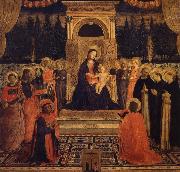 |
Angelico Fra
|
|
Italian painter, illuminator and Dominican friar. He rose from obscure beginnings as a journeyman illuminator to the renown of an artist whose last major commissions were monumental fresco cycles in St Peter and the Vatican Palace, Rome. He reached maturity in the early 1430s, a watershed in the history of Florentine art. None of the masters who had broken new ground with naturalistic painting in the 1420s was still in Florence by the end of that decade. The way was open for a new generation of painters, and Fra Angelico was the dominant figure among several who became prominent at that time, including Paolo Uccello, Fra Filippo Lippi and Andrea del Castagno. By the early 1430s Fra Angelico was operating the largest and most prestigious workshop in Florence. His paintings offered alternatives to the traditional polyptych altarpiece type and projected the new naturalism of panel painting on to a monumental scale. In fresco projects of the 1440s and 1450s, both for S Marco in Florence and for S Peter's and the Vatican Palace in Rome, Fra Angelico softened the typically astringent and declamatory style of Tuscan mural decoration with the colouristic and luminescent nuances that characterize his panel paintings. His legacy passed directly to the second half of the 15th century through the work of his close follower Benozzo Gozzoli and indirectly through the production of Domenico Veneziano and Piero della Francesca. Fra Angelico was undoubtedly the leading master in Rome at mid-century, and had the survival rate of 15th-century Roman painting been greater, his significance for such later artists as Melozzo da Forli and Antoniazzo Romano might be clearer than it is.
|
|
 |
Angelika Kauffmann
|
|
1741-1807,Swiss neoclassical painter and graphic artist. From her youth she was known for her artistic, musical, and linguistic abilities. She went to England, where she enjoyed success as a fashionable portrait painter and decorator. A protegee of Sir Joshua Reynolds, Kauffman was one of the original members of the Royal Academy. She often decorated houses designed by the Adam brothers. After her marriage in 1781 to the Venetian painter Antonio Zucchi, she lived in Italy, where she flourished in artistic and literary circles. Reynolds, Winckelmann, Goethe, and Garrick commissioned her to paint their portraits. Representative works include Religion (National Gall., London); Self-Portrait (Staatliche Museen, Berlin); and the etchings of L'Allegra and La Pensierosa. The British Museum has a collection of her drawings and prints. |
|
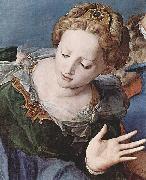 |
Angelo Bronzino
|
|
(November 17, 1503 - November 23, 1572), usually known as Il Bronzino, or Agnolo Bronzino (mistaken attempts also have been made in the past to assert his name was Agnolo Tori and even Angelo (Agnolo) Allori), was an Italian Mannerist painter from Florence. The origin of his nickname, Bronzino is unknown, but could derive from his dark complexion, or from that he gave many of his portrait subjects.
Bronzino was born in Florence. According to his contemporary Vasari, Bronzino was a pupil first of Raffaellino del Garbo, and then of Pontormo. The latter was ultimately the primary influence on Bronzino's developing style and the young artist remained devoted to his eccentric teacher. |
|
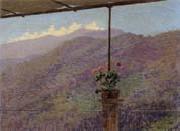 |
Angelo Morbelli
|
|
Alessandria 1853-1918 Milan,Italian painter. He received his first lessons in drawing in Alessandria, and in 1867 he travelled on a local study grant to Milan, where he was based for the rest of his life. He enrolled at the Accademia di Brera and from 1867 to 1876 studied drawing and painting there under Raffaele Casnedi and Giuseppe Bertini, whose influence is seen in both the subject-matter and technique of his early works. These include perspectival views, anecdotal genre scenes and history paintings. In the Dying Goethe (1880; Alessandria, Pin. Civ.) the theatrical setting, enriched by a sophisticated execution and a well-modulated use of colour, derives from the teaching of Casnedi and Bertini, while the historic-romantic quality of this painting also recalls the style of Francesco Hayez. |
|
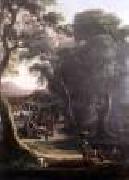 |
ANGELUCCIO
|
|
Italian painter, Roman school (active 1640-1650 in Rome)
Italian painter. He is the only known pupil of Claude Lorrain other than Claude's long-standing assistant Giandomenico Desiderii (b 1620-24; d after 1657). Pascoli, the only biographer to record him, claimed in his life of Claude that Angeluccio was Claude's most able student but had died young and was able to work little. Angeluccio appears to have lived in Rome and, like Claude, was exclusively a landscape painter. About 25 paintings and 35 drawings, all dated 1640-45, comprise his entire oeuvre. Claude's influence can be seen in such paintings as Landscape with Figures and Bridge (priv. col., see 1983 exh. cat., no. 88). This is a composition with centrally placed foreground figures framed by trees in the middle ground, which in turn stand before a bridge and a distant vista, and was borrowed directly from such paintings by Claude as Pastoral Landscape (1644-5; Merion Station, PA, Barnes Found.). Although Angeluccio shared Claude's approach to landscape, he was not merely an imitator. His paintings form a coherent stylistic group of wooded landscapes, rich in foliage and undergrowth and characterized by a blue-green tonality, which indicates that he also embraced the tradition of landscape painting brought to Rome in the 17th century by Dutch and Flemish artists. The Landscape with Hunters (Rome, Pal. Barberini), painted on an intimate scale and aligned vertically, like most of Angeluccio's paintings, betrays the artist's debt to this tradition. In the painting the pockets of sunlight and the highlighted foliage, indicated with the abbreviated white brushstrokes typical of Angeluccio's manner, provide sharp contrast to a dark, tunnel-like wood. The resulting sense of the landscape closing in on the figures is an effect often found in the landscapes of the Flemish artist Paul Bril. The distant vista, however, is similar to those that appear in works by Claude. The romanticism evoked by this blending of borrowed elements gives Angeluccio's works their distinguishing quality. His paintings frequently also contain rustic genre figures. |
|
|

